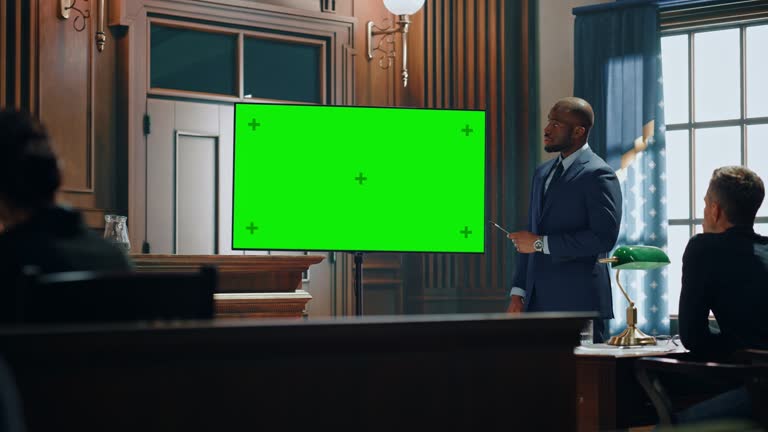Browsing the Complexities of Trial Presentations: Tips for Seamless Distribution and Engaging Disagreements
In the realm of lawful process, the art of trial presentation stands as a critical component of success. The intricacies intrinsic in trial discussions require a delicate equilibrium of skill, ability, and method.

Recognizing Trial Purposes
To effectively browse a trial, it is important to have a clear understanding of the objectives that need to be accomplished. Prior to stepping right into the court room, legal teams must specify their objectives and preferred end results. These objectives act as assisting concepts throughout the test, forming techniques and influencing decision-making procedures.
Understanding trial goals includes a thorough analysis of the instance, lawful criteria, and the customer's ideal interests. Trial Presentations. It calls for a meticulous exam of the truths, identifying vital issues, and preparing for prospective challenges. By setting measurable and certain objectives, lawyers can customize their arguments and presentations to line up with the preferred results
Moreover, a clear grip of test objectives allows lawful teams to focus on evidence, witnesses, and lawful debates properly. It permits the development of a meaningful narrative that reverberates with the court and jury, strengthening the total instance discussion.

Organizing Evidence Effectively
Having a clear understanding of trial purposes lays the structure for organizing evidence properly in lawful proceedings - Trial Presentations. By aligning the presentation of evidence with the wanted results of the trial, lawful groups can enhance their arguments and improve their persuasiveness. One critical aspect of arranging proof is classification. Organizing proof based upon styles or relevance to details lawful elements can assist streamline the discussion and make complex info much more digestible for the judge or court.
Another key element in organizing proof properly is developing a sensible circulation. Offering evidence in a consecutive and meaningful fashion can assist build a compelling narrative that supports the legal debates being made. Additionally, making use of aesthetic help such as timelines, graphs, or charts can even more improve the organization of evidence and help in clarifying complicated partnerships or sequences of events.
In addition, making certain that all proof offered is acceptable and appropriate to the situation is important. Inadmissible or irrelevant evidence can diminish the toughness of the disagreement and possibly damage the reputation of the here and now event. A meticulous testimonial and choice procedure ought to be undertaken to consist of only the most lawfully sound and impactful evidence in the trial discussion.
Crafting Convincing Stories
Crafting engaging narratives plays a pivotal function in presenting convincing arguments throughout legal proceedings. When creating a story for a test discussion, it is vital to establish a clear story that highlights crucial factors and attaches them in a meaningful manner. By weaving together proof, testament, and legal debates into a persuasive and additional reading cohesive narrative, legal specialists can properly support for their clients and enhance the likelihood of a beneficial outcome in see this site the courtroom.
Mastering Aesthetic Aids
Efficient use aesthetic aids is vital to improving the effect and clarity of trial presentations. Visual aids, when used purposefully, have the power to simplify complex details, enhance bottom lines, and leave a long-term impression on the judge and court. To master visual aids in test discussions, it is crucial to guarantee that they are clear, concise, and appropriate to the debates being made.
When including aesthetic help, such as charts, timelines, photographs, or graphs, into a trial discussion, it is essential to keep them visually appealing yet expert. The visuals ought to complement the spoken arguments, providing a visual representation of the details being talked about without frustrating the audience with unneeded details.
Moreover, exercising with the aesthetic aids beforehand is critical to make certain a smooth distribution during the test. Familiarizing oneself with the web content, changes, and timings of each visual aid can aid preserve the circulation of the discussion and stop technical problems that may arise.
Supplying Impactful Closing Disagreements
A compelling closing debate serves as the end result of a trial presentation, look at here enveloping the core narrative and encouraging the court and jury in the direction of a desirable decision. Begin by detailing the major debates that support your customer's placement, emphasizing why the proof offered throughout the test sustains your story.
Additionally, incorporating psychological appeal can better strengthen your closing argument. Eventually, a well-crafted closing argument need to leave a long lasting impact, engaging the court and jury to rule in your customer's favor.
Verdict
To conclude, understanding test discussions entails recognizing purposes, arranging evidence, crafting narratives, using aesthetic aids, and supplying impactful closing arguments. By implementing these approaches properly, attorneys can present their instance perfectly and make compelling debates in the court room. It is critical to navigate the complexities of trial presentations with accuracy and skill to attain success in lawful proceedings.
By lining up the discussion of evidence with the desired results of the test, lawful teams can strengthen their arguments and boost their persuasiveness (Trial Presentations). To understand visual help in trial presentations, it is critical to ensure that they are clear, concise, and relevant to the arguments being made
A compelling closing disagreement offers as the end result of a trial discussion, encapsulating the core narrative and encouraging the court and jury towards a desirable decision. Begin by detailing the major disagreements that sustain your customer's setting, highlighting why the evidence offered throughout the trial supports your narrative.In verdict, mastering test presentations includes understanding goals, arranging evidence, crafting narratives, using visual help, and supplying impactful closing arguments.
Comments on “Why Your Next Instance Requirements a Strong Trial Presentation: Insights and Techniques for Legal representatives”